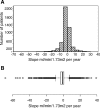Long-term graft function changes in kidney transplant recipients
- PMID: 20508857
- PMCID: PMC2875040
- DOI: 10.1093/ndtplus/sfq063
Long-term graft function changes in kidney transplant recipients
Abstract
Background. Monitoring changes in glomerular filtration rate (GFR) is the recommended method for assessing the progression of kidney disease. The aim of this study was to assess the decline of graft function defined by the annualized change in GFR and the factors which affect it.Methods. Four thousand four hundred and eighty-eight patients, transplanted during the years 1990, 1994, 1998 and 2002 in 34 centres in Spain with allograft survival of at least 1 year, were included in the study. GFR was estimated using the four-variable equation of the Modification of Diet in Renal Diseases (MDRD) study. Linear mixed effects model was applied to determine the relation between the covariates and the annualized change in GFR after transplantation.Results. The average GFR at 12 months was 51.4 +/- 18.9 mL/min/1.73 m(2); most patients were in stage 3 of chronic kidney disease classification. The average patient slope, calculated in a linear model with varying-intercept and varying-slope without covariates, was -1.12 +/- 0.05 mL/min/year (slope +/- standard error). Some variables were related to both the 12-month GFR (intercept) and the slope: recipient gender, hepatitis C virus (HCV) status, estimated GFR (eGFR) at 3 months and proteinuria at 12 months. Some variables were only related to the slope of eGFR: time on dialysis, primary renal disease and immunosuppression. Others affected only the 12-month GFR: donor age, delayed graft function, acute rejection and systolic blood pressure at 12 months. Higher graft function at 3 months had a negative impact on the GFR slope. Cyclosporine-based immunosuppression had a less favourable effect on the rates of change in allograft function.Conclusions. There was a slow decline in GFR. Poor graft function was not associated with an increased rate of decline of allograft function. Immunosuppression with cyclosporine displayed the worst declining GFR rate.
Figures
Similar articles
-
Association between preoperative allograft function (effective renal plasma flow) and the change in glomerular filtration rate among living-donor kidney transplant recipients.Transplant Proc. 2012 Jan;44(1):248-53. doi: 10.1016/j.transproceed.2011.11.045. Transplant Proc. 2012. PMID: 22310624
-
Sodium bicarbonate for kidney transplant recipients with metabolic acidosis in Switzerland: a multicentre, randomised, single-blind, placebo-controlled, phase 3 trial.Lancet. 2023 Feb 18;401(10376):557-567. doi: 10.1016/S0140-6736(22)02606-X. Epub 2023 Jan 25. Lancet. 2023. PMID: 36708734 Clinical Trial.
-
The effect of maintenance immunosuppression medication on the change in kidney allograft function.Kidney Int. 2004 Feb;65(2):692-9. doi: 10.1111/j.1523-1755.2004.00431.x. Kidney Int. 2004. PMID: 14717943
-
Chronic kidney disease in renal transplant recipients.Transplant Proc. 2005 Nov;37(9):3718-20. doi: 10.1016/j.transproceed.2005.09.101. Transplant Proc. 2005. PMID: 16386516
-
The utility of cyclosporine weaning in renal transplantation.Ann Surg. 1992 Apr;215(4):368-76. doi: 10.1097/00000658-199204000-00011. Ann Surg. 1992. PMID: 1558418 Free PMC article. Review.
Cited by
-
Long-term renal graft outcome after parathyroidectomy - a retrospective single centre study.BMC Nephrol. 2020 Feb 18;21(1):53. doi: 10.1186/s12882-020-01723-x. BMC Nephrol. 2020. PMID: 32070317 Free PMC article.
-
The safety of indocyanine green in patients with advanced chronic kidney disease or kidney transplantation: a scoping review.Ann Med Surg (Lond). 2024 Nov 18;87(3):1351-1359. doi: 10.1097/MS9.0000000000002713. eCollection 2025 Mar. Ann Med Surg (Lond). 2024. PMID: 40213189 Free PMC article. Review.
-
High Serum Level of β2-Microglobulin in Late Posttransplant Period Predicts Subsequent Decline in Kidney Allograft Function: A Preliminary Study.Dis Markers. 2015;2015:562580. doi: 10.1155/2015/562580. Epub 2015 Nov 8. Dis Markers. 2015. PMID: 26633915 Free PMC article.
-
Jointly modelling multiple transplant outcomes by a competing risk model via functional principal component analysis.J Appl Stat. 2021 Sep 22;50(1):43-59. doi: 10.1080/02664763.2021.1981256. eCollection 2023. J Appl Stat. 2021. PMID: 36530777 Free PMC article.
-
Prognostic value for long-term graft survival of estimated glomerular filtration rate and proteinuria quantified at 3 months after kidney transplantation.Clin Kidney J. 2020 Apr 26;13(5):791-802. doi: 10.1093/ckj/sfaa044. eCollection 2020 Oct. Clin Kidney J. 2020. PMID: 33125000 Free PMC article.
References
-
- Meier-Kriesche H-U, Schold JD, Srinivas TR, Kaplan B. Lack of improvement in renal allograft survival despite a marked decrease in acute rejection rates over the most recent era. Am J Transplanit. 2004;4:378–383. - PubMed
-
- Marcén R, Fernández-Rodriguez A, Rodriguez-Mendiola N, et al. Evolution of rejection rates and kidney graft survival: a historical analysis. Transplant Piroc. 2009;41:2357–2359. - PubMed
-
- Excerpts from the United States Renal Data System 2008 Annual Data Report: atlas of chronic kidney disease & end-stage renal disease in the United States. Am J Kidney Dis. 2009;53:S1–S372. - PubMed
-
- Hariharan S, McBride MA, Cherikh WS, et al. Post-transplant renal function in the first year predicts long-term kidney transplant survival. Kidney Int. 2002;62:311–318. - PubMed
-
- K/DOQI Clinical Practice Guidelines for Chronic Kidney Disease. Evaluation, classification, and stratification. Am J Kidney Dis. 2002;39:S1–S266. - PubMed
LinkOut - more resources
Full Text Sources
Other Literature Sources
Research Materials
Miscellaneous


